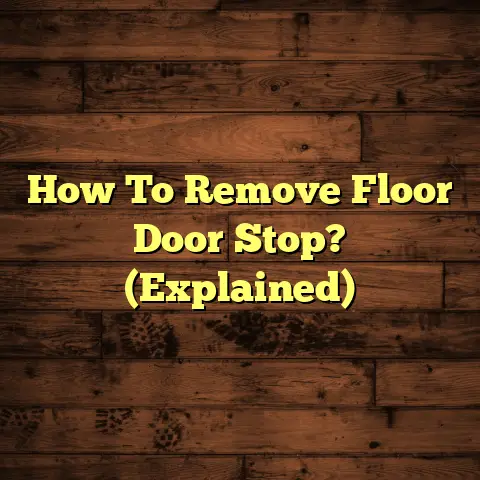Clean Glue Off Tile Fast! (3 Grout Line Saviors!)
Ever had that sinking feeling after a tiling project? You step back to admire your work, and BAM! Glue residue staring back at you, mocking your efforts.
It’s a common headache, believe me, I’ve seen it all in my years as a flooring contractor.
Tiles and grout are like the smile of your home. Especially in kitchens and bathrooms, where a clean, fresh look is vital.
But don’t worry! I’m here to tell you that you don’t need to break the bank to restore that sparkle.
We’re diving into budget-friendly solutions that will have your tiles looking brand new, without emptying your wallet. Ready to get started? Let’s dive in!
Section 1: Understanding Glue Residue
Let’s talk glue. Not all glues are created equal, and knowing what you’re dealing with is half the battle.
In the tile world, we commonly see a few types:
-
Tile Adhesives (Thin-Set Mortar): These are the workhorses. They create a strong bond between the tile and the subfloor. Often cement-based, they can leave a stubborn, chalky residue.
-
Mastic: Typically used for wall tiles, mastic is an organic adhesive. It’s generally easier to clean than thin-set, but can still be tricky.
-
Construction Adhesives (Like Liquid Nails): These are the heavy-duty guys. They’re incredibly strong, and their residue can be a real pain.
Why is glue residue so tough to remove?
Well, it’s designed to stick! These adhesives form strong bonds, making them resistant to simple wiping.
Plus, some glues react with the tile surface, creating a chemical bond. If you try to force it off, you risk scratching or damaging the tile.
And let’s not forget the grout lines. Those narrow crevices are glue’s favorite hiding spots.
If left unattended, glue can discolor grout, creating an unsightly mess. Worse, it can trap moisture, leading to mold and mildew growth. Yuck!
Section 2: Budget Options for Cleaning Glue Off Tile
Alright, let’s get to the good stuff. Here are my top 3 budget-friendly methods for banishing glue residue:
2.1 Vinegar and Baking Soda Solution
Ah, the dynamic duo! Vinegar and baking soda are like the Batman and Robin of the cleaning world – powerful and readily available.
How does it work?
The magic lies in the chemical reaction. Vinegar (an acid) reacts with baking soda (a base), creating carbon dioxide gas. This fizzing action helps to lift the adhesive from the tile surface.
Here’s the recipe:
-
Make a paste: Mix baking soda and white vinegar until it forms a thick, spreadable paste. I usually start with a 1:1 ratio, adjusting as needed.
-
Apply the paste: Generously apply the paste to the glue-covered areas. Make sure to get into those grout lines!
-
Dwell time: Let the paste sit for 15-20 minutes. This gives the chemical reaction time to work its magic.
-
Scrub-a-dub-dub: Using a non-abrasive scrubbing pad or an old toothbrush, scrub the affected areas in a circular motion. For grout lines, use the toothbrush to get into those tight spaces.
-
Rinse and dry: Thoroughly rinse the area with clean water. Use a clean cloth or towel to dry the surface.
Pro Tips:
- For stubborn spots, try adding a bit more vinegar to the paste for extra fizz.
- Avoid using abrasive scrubbers, as they can scratch the tile surface.
- Work in small sections to prevent the paste from drying out.
Why this works: The fizzing action of vinegar and baking soda helps loosen the glue’s grip, making it easier to scrub away. Plus, it’s a natural and safe cleaning solution.
2.2 Rubbing Alcohol or Isopropyl Alcohol
Rubbing alcohol is another fantastic solvent that can dissolve glue. It’s readily available and relatively inexpensive.
How does it work?
Rubbing alcohol works by breaking down the chemical bonds in the adhesive, causing it to lose its grip on the tile surface.
Here’s how to use it:
-
Apply liberally: Soak a cotton ball or clean cloth with rubbing alcohol.
-
Target the glue: Gently dab the alcohol onto the glue residue, saturating the area.
-
Wait it out: Allow the alcohol to sit for 5-10 minutes. This gives it time to penetrate and dissolve the glue.
-
Wipe away: Use a clean cloth to wipe away the softened glue.
-
Repeat if needed: For stubborn spots, repeat the process until the glue is gone.
Safety First!
- Ventilation: Always work in a well-ventilated area when using rubbing alcohol.
- Skin protection: Wear gloves to protect your skin from irritation.
- No flames: Keep rubbing alcohol away from open flames and heat sources.
Follow-up Cleaning:
After using rubbing alcohol, it’s a good idea to clean the area with a mild soap and water solution to remove any remaining residue.
Why this works:
Rubbing alcohol is a powerful solvent that can dissolve many types of glue. It’s also relatively safe to use on tile surfaces.
2.3 Dish Soap and Hot Water Mixture
Sometimes, the simplest solutions are the most effective. A mixture of dish soap and hot water can work wonders on glue residue.
How does it work?
The hot water helps to soften the glue, while the dish soap acts as a surfactant, helping to lift the adhesive from the tile surface.
Here’s the recipe:
-
Mix it up: Combine a few drops of dish soap with hot water in a bucket or bowl.
-
Soak it in: Dip a sponge or cloth into the soapy water and wring out the excess.
-
Apply generously: Apply the soapy water to the glue residue, making sure to saturate the area.
-
Let it soak: Allow the soapy water to sit for 10-15 minutes to soften the glue.
-
Scrub gently: Use a non-abrasive scrubbing pad or sponge to gently scrub the area.
-
Rinse and dry: Rinse the area with clean water and dry with a clean cloth.
Benefits:
- Gentle on grout: This method is safe for use on grout lines without causing damage.
- Effective on light residue: Ideal for removing light glue residue or haze.
- Easy to maintain: Regular cleaning with dish soap and water can help prevent future glue issues.
Maintaining Tile Surfaces:
To prevent future glue issues, clean your tile surfaces regularly with a mild soap and water solution. Avoid using harsh chemicals or abrasive cleaners, as they can damage the tile and grout.
Why this works:
Dish soap is designed to cut through grease and grime, making it effective at lifting adhesive residue. The hot water helps to soften the glue, making it easier to remove.
Section 3: Advanced Techniques for Stubborn Glue
Okay, so what if you’ve tried the budget-friendly methods and the glue is still stubbornly clinging on? Don’t despair!
There are a few advanced techniques you can try that might require a slight investment, but are still relatively cost-effective.
-
Plastic Scrapers: These are a must-have for any DIYer. They’re inexpensive and can be used to gently scrape away stubborn glue without scratching the tile surface.
-
Steam Cleaners: A steam cleaner can be a great investment for cleaning tile and grout. The hot steam helps to loosen the glue, making it easier to wipe away.
-
Commercial Adhesive Removers: These are specifically designed to remove adhesive residue. Follow the manufacturer’s instructions carefully, and always test in an inconspicuous area first.
When to Invest?
If you’re dealing with a large area of stubborn glue residue, it might be worth investing in a steam cleaner or commercial adhesive remover.
However, for smaller areas, the DIY methods should suffice.
Conclusion
So there you have it – my top 3 budget-friendly methods for cleaning glue off tile and grout lines:
- Vinegar and Baking Soda Solution
- Rubbing Alcohol or Isopropyl Alcohol
- Dish Soap and Hot Water Mixture
Remember, addressing glue issues promptly is key to avoiding permanent damage to your tiles and grout.
Don’t let that glue linger!
I encourage you to try these methods at home and see what works best for you. Every situation is different, and sometimes a little experimentation is needed.
Call to Action
Now it’s your turn! Have you tried any of these methods? What are your go-to tricks for removing glue from tile?
Share your experiences and tips in the comments below. Let’s learn from each other and create a community of DIY enthusiasts!
And be sure to follow my blog/website for more home improvement tips and DIY guides in the future.
Happy cleaning!





